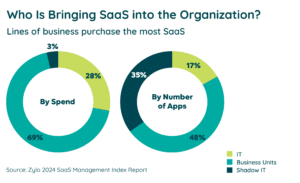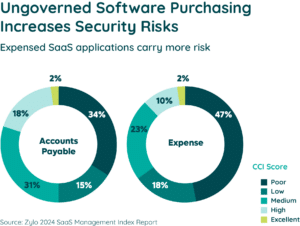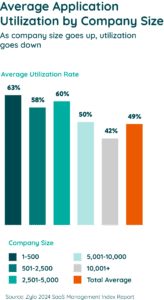Table of Contents
Software Asset Management (SAM) pros like you usually spend most of your time looking after the main software your company utilizes, like Microsoft or Adobe. That’s understandable, because they typically incur the highest costs and the most attention from management due to being business-critical.
But what about the smaller, lesser-known software titles? These “longtail SaaS applications” are often employee-purchased for specific use cases and remain outside IT’s scope. These apps are many and varied and fly under the radar because of their smaller cost footprint, but they’re no less important when considered in aggregate.
Things are changing fast, and SaaS is no exception. Can your current management software keep up? The data says no.
Here at Zylo, we’re leading the way in changing how people think about SaaS because we know how important it is to understand and manage all the software a company uses—both big and small. This includes the many smaller applications that are becoming more common in today’s business operations.
This article will delve deeper into the implications of this paradigm shift, exploring the importance of ongoing SaaS discovery, the security risks associated with longtail apps, and compliance considerations. We’ll also touch on optimization opportunities, and the need for a proactive approach to managing the evolving software landscape.
The Rise of Longtail SaaS Apps
The proliferation of Software as a Service (SaaS) solutions has led to a veritable explosion of longtail applications. These applications, which cater to specific departments or niche use cases, are quickly becoming integral to organizational workflows.
Our Zybrary has identified over 22,000 SaaS applications, highlighting the sheer abundance of options available to businesses. With a longtail app available for every conceivable use case, the software usage landscape has become increasingly crowded.
While smaller applications may not be a significant concern for SAM professionals due to minimal spend or usage, the advent of SaaS has changed the game. Despite constituting a small portion of an organization’s overall software expenditure, longtail SaaS applications collectively pose notable challenges. These challenges range from security risks and unexpected costs to a lack of control and visibility.
Unlike their on-premises counterparts, longtail apps operate outside the purview of IT departments, contributing to the growing phenomenon of shadow IT.
Why Ongoing Discovery on Longtail SaaS Apps Matters
Ongoing discovery is not just a task, it’s a vital tool for SAM professionals to gain visibility into the entire software landscape. Longtail apps, often used without IT oversight, are a significant portion of shadow IT. While each app may only represent a small portion of spending (around 3%), together they make up a substantial 35% of the software stack.
 By actively engaging in ongoing discovery, SAM professionals can take control of this significant portion of the software landscape, empowering them to make informed decisions and drive operational excellence.
By actively engaging in ongoing discovery, SAM professionals can take control of this significant portion of the software landscape, empowering them to make informed decisions and drive operational excellence.
Beyond their cost, shadow IT also brings other risks. These apps often lack adequate security measures, leaving organizations open to data breaches and cyber threats. Additionally, their decentralized nature complicates efforts to meet regulatory requirements, potentially leading to legal and reputational issues.
Stay Ahead of Security Risks
Due to the lack of vetting and oversight, the security posture of these longtail SaaS apps remains largely unknown. Our data shows that 65% of expensed apps carry a “Poor” or “Low” security score, indicating widespread vulnerabilities within this software category. You can’t address what you can’t see, and shadow IT frequently slips past organizational oversight and protocols.
 Security vulnerabilities can have consequences ranging from data breaches to PII exposures, potentially leading to substantial financial losses, reputational damage, and legal liabilities. Enterprises must centralize every app before they can proactively address these security risks. Implementing robust security measures and conducting thorough assessments of longtail applications can only happen after the discovery phase.
Security vulnerabilities can have consequences ranging from data breaches to PII exposures, potentially leading to substantial financial losses, reputational damage, and legal liabilities. Enterprises must centralize every app before they can proactively address these security risks. Implementing robust security measures and conducting thorough assessments of longtail applications can only happen after the discovery phase.
Address Compliance Concerns
Without ongoing discovery and evaluation, SAM professionals will struggle to address compliance concerns, which only increase with longtail apps. If purchased outside of policy, many of these applications may not adhere to industry regulations or data privacy laws, posing a direct threat to compliance efforts. The use of non-compliant apps can result in hefty fines, reputational harm, and other legal ramifications.
The decentralized nature of longtail apps also complicates efforts to maintain regulatory compliance. Without the right visibility into the data practices of these applications, organizations will struggle to enforce data governance frameworks.
Open the Door to Optimization Opportunities
Proactive management of longtail apps does more than just address security risks and compliance concerns. It also presents significant optimization opportunities. By identifying underutilized licenses and consolidating redundant functions across longtail applications, you can streamline your software ecosystem and maximize your app spend ROI. By taking a proactive approach, SAM professionals can not only mitigate risks but also drive significant cost savings and operational efficiency.
 On average, enterprises utilize only 42% of their SaaS licenses, resulting in a staggering $127 million in wasted spend annually. This underutilization highlights the need for enterprises to conduct thorough assessments of their software usage and licensing agreements to identify optimization opportunities.
On average, enterprises utilize only 42% of their SaaS licenses, resulting in a staggering $127 million in wasted spend annually. This underutilization highlights the need for enterprises to conduct thorough assessments of their software usage and licensing agreements to identify optimization opportunities.
Furthermore, by consolidating functionality across redundant longtail apps, you can simplify the software landscape and reduce your app stack complexity. This consolidation leads to cost savings and improves operational efficiency and user experience.
Optimizing SaaS licenses and consolidating app functionality across your longtail stack are essential for organizations that want to maximize the value of their software investments. In this crucial task, SAM professionals play a pivotal role. Their expertise and vigilance in identifying and implementing these opportunities provide ongoing value in the ever-changing world of digital assets, making them an integral part of the company’s operations.
Get a Handle on Longtail SaaS Apps
It’s evident that managing longtail SaaS apps presents unique challenges and opportunities for the enterprise. From addressing security risks and compliance concerns to optimizing expenditures and streamlining operations, SAM professionals play a key role in helping navigate the complexities of modern software ecosystems.
Managing longtail apps is not a one-time task, but a continuous process that demands ongoing attention and vigilance. On average, 6 new SaaS apps enter organizational environments every month. This underscores the need for organizations to continuously monitor their software landscapes, identifying and managing emerging applications on an ongoing basis.
By adopting a proactive approach to ongoing discovery, evaluation, and optimization, organizations can mitigate risks, maximize the value of their software investments, and ensure compliance with regulatory requirements. SAM professionals, armed with the right tools and strategies, are well-positioned to lead these efforts and drive operational excellence and innovation in today’s dynamic SaaS environment.
Learn how Zylo can help support your Software Asset Management practice.

